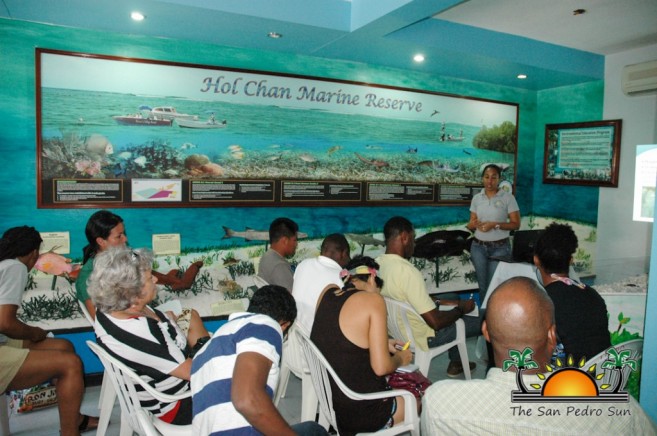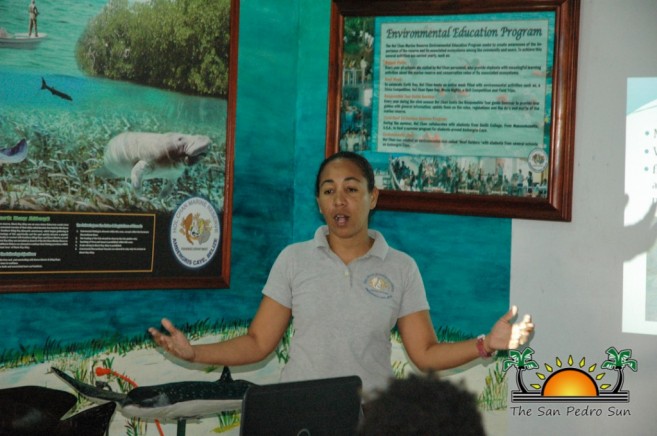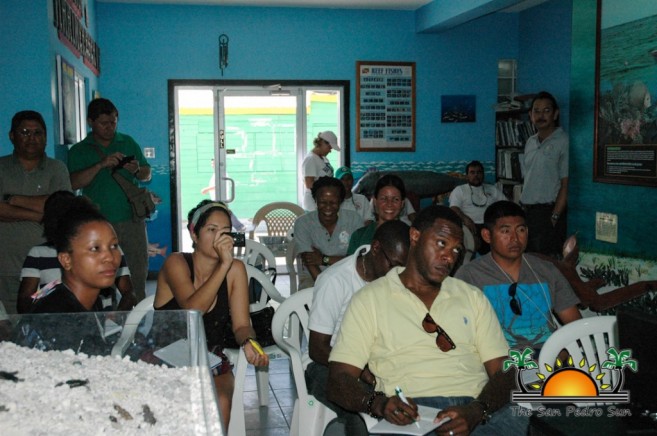Regional officers of various Caribbean protected areas were in Belize for a six-day work exchange visit. Their stay in Belize from 3rd to the 8th of February was part of a project being implemented in the African, Caribbean and Pacific (ACP) group of countries through the Biodiversity and Protected Areas Management Programme (BIOPAMA). The group visited three protected areas, including Hol Chan Marine Reserve and the Bacalar Chico Marine Reserve on Ambergris Caye during their visit to the only Caribbean country in Central America.
 BIOPAMA is a four-year project that is being executed by the International Union for Conservation of Nature (IUCN) and the European Commission (EC) Joint Resource Center. For the execution of the project, the ACP countries have been broken down into four smaller BIOPAMA regions; Western and Central Africa, Eastern and Southern Africa, the Caribbean and the Pacific. The scope of the project is broken down into two components; capacity building in protected area management done by the IUCN, and an Access and Benefit Sharing component executed by a European based organization. “We are supporting the development and enhancement of protected area management throughout the region. The manner in which capacity building will be rolled out is twofold. We are looking at specific initiatives geared directly at capacity building, whether it is in training of protected areas managers or developing materials that will support their protected areas management tools to do their work. On the other side we are looking to set up, in each of the regions, something we call an observatory. It’s basically a center for data and information that will support protected areas management decision making,” said Hyacinth Armstrong-Vaughn, BIOPAMA’s Protected Areas Officer.
BIOPAMA is a four-year project that is being executed by the International Union for Conservation of Nature (IUCN) and the European Commission (EC) Joint Resource Center. For the execution of the project, the ACP countries have been broken down into four smaller BIOPAMA regions; Western and Central Africa, Eastern and Southern Africa, the Caribbean and the Pacific. The scope of the project is broken down into two components; capacity building in protected area management done by the IUCN, and an Access and Benefit Sharing component executed by a European based organization. “We are supporting the development and enhancement of protected area management throughout the region. The manner in which capacity building will be rolled out is twofold. We are looking at specific initiatives geared directly at capacity building, whether it is in training of protected areas managers or developing materials that will support their protected areas management tools to do their work. On the other side we are looking to set up, in each of the regions, something we call an observatory. It’s basically a center for data and information that will support protected areas management decision making,” said Hyacinth Armstrong-Vaughn, BIOPAMA’s Protected Areas Officer.
 The multi-million dollar project, now in the second of its four year tenure, is expected to impact 11 of the world’s 25 biodiversity hotspots which are all found in ACP countries. BIOPAMA covers terrestrial and marine protected areas (MPA). What gives the project more emphases in MPAs in this region is the fact that the Caribbean has roughly three times more marine areas that are protected than on land. “ACP countries are hotspots for biodiversity but because of the lack of resources, whether it is human or financial, we realize that it is not being protected and sustained the way it should be. BIOPAMA is meant to give support where the support is not there and increase the human capacity to be able to better protect the areas and improve in protected area management,” said Vaughn.
The multi-million dollar project, now in the second of its four year tenure, is expected to impact 11 of the world’s 25 biodiversity hotspots which are all found in ACP countries. BIOPAMA covers terrestrial and marine protected areas (MPA). What gives the project more emphases in MPAs in this region is the fact that the Caribbean has roughly three times more marine areas that are protected than on land. “ACP countries are hotspots for biodiversity but because of the lack of resources, whether it is human or financial, we realize that it is not being protected and sustained the way it should be. BIOPAMA is meant to give support where the support is not there and increase the human capacity to be able to better protect the areas and improve in protected area management,” said Vaughn.
According to Vaughn, in the Caribbean, MPAs are more developed than terrestrial protected areas, with Belize having one of the strongest MPA systems. For that reason, countries that are facing challenges in MPAs have been identified and invited to see firsthand how they are managed in Belize. Junior Marine Protected Area Officers, who conduct the day-to-day job in protected areas, were invited to attend the capacity building initiative. “Junior level professional require some exposure; they are young and have ideas. They have come into a system that for some, it may be frustrating depending on the type of set up they have. Others are coming from a system that doesn’t exist at all because there are countries that are new to protected areas. We decided to bring them to Belize because this country has a good history of protected area management. For the region, Belize has a robust protected areas management system. Of course while all is not perfect, there are success stories that can be useful to these participants, who can then strengthen what they are doing, or even develop policy papers,” explained Vaughn.
 The group of participants included two from Barbados, one from Grenada, one from Saint Kitts and Nevis, one from the Dominican Republic and one from southern Belize. While in Belize, they met with the Belize Fisheries Department and various protected areas management agencies such as the Belize Audubon Society, The Protected Areas Conservation Trust and ECOMAR. The visiting group also travelled to Sarteneja in the Corozal District where they met with the Sarteneja Lions for Conservation and Development and saw how the protected areas have impacted a traditional fishing community. Following their visit to mainland Belize, the group came to Ambergris Caye on February 6th, 7th and 8th. While here, they had the opportunity to see the way two marine protected areas have evolved and the impact they have had on the development of a tourism dependent island and the role the community plays in the protected areas.
The group of participants included two from Barbados, one from Grenada, one from Saint Kitts and Nevis, one from the Dominican Republic and one from southern Belize. While in Belize, they met with the Belize Fisheries Department and various protected areas management agencies such as the Belize Audubon Society, The Protected Areas Conservation Trust and ECOMAR. The visiting group also travelled to Sarteneja in the Corozal District where they met with the Sarteneja Lions for Conservation and Development and saw how the protected areas have impacted a traditional fishing community. Following their visit to mainland Belize, the group came to Ambergris Caye on February 6th, 7th and 8th. While here, they had the opportunity to see the way two marine protected areas have evolved and the impact they have had on the development of a tourism dependent island and the role the community plays in the protected areas.
 During their visit, the participants were exposed to and got a clear understanding of the enforcement of fisheries regulations in Belize. They learned about education and community outreach initiatives, the role of shared management between the government agency and local groups, the working relationship with local fishers to ensure compliance with regulations, sources of financing and business operations of protected areas and potential for local ecotourism business.
During their visit, the participants were exposed to and got a clear understanding of the enforcement of fisheries regulations in Belize. They learned about education and community outreach initiatives, the role of shared management between the government agency and local groups, the working relationship with local fishers to ensure compliance with regulations, sources of financing and business operations of protected areas and potential for local ecotourism business.
Their visit was possible through the coordination of the Caribbean Marine Protected Areas Management with the assistance of Belize Fisheries Department and the Government of Belize.
BIOPAMA trains regional officers using Belize’s robust protected areas system

Share
Read more

